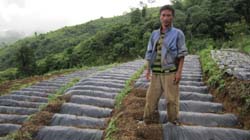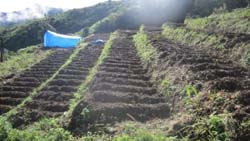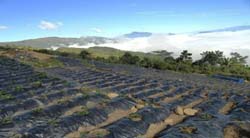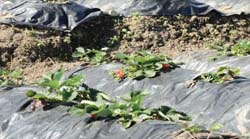 Mr. Jonathan (28), a young farmer of village Km Sawm (VC-III), district Saiha of Mizoram was not able to earn enough for his family of four members due to lack of resources. But now, he is earning Rs. 3.5 to 4 lakhs per annum from one hectare of land for upkeep of his family. An initiative of National Agricultural Innovation Project (NAIP) has changed his life forever. He was selected as one of the strawberry beneficiaries of NAIP in the area.
Mr. Jonathan (28), a young farmer of village Km Sawm (VC-III), district Saiha of Mizoram was not able to earn enough for his family of four members due to lack of resources. But now, he is earning Rs. 3.5 to 4 lakhs per annum from one hectare of land for upkeep of his family. An initiative of National Agricultural Innovation Project (NAIP) has changed his life forever. He was selected as one of the strawberry beneficiaries of NAIP in the area.
ICAR Took Initiative
Saiha, about 400 km from Aizawl is the remotest and backward district of Mizoram as identified by Planning Commission and is bordering Myanmar on the eastern and southern side. Most of the farmers were practicing Jhum farming system in the district. ICAR Research Complex for NEH region, Mizoram centre adopted three villages viz., Km Sawm (VC-III) and Niawhtlang (VC-I and II) under NAIP, Component-III in 2011-12 to raise farm income and improve the livelihood of farmers. Centre introduced strawberry cultivation with improved technological interventions under the project.
Technological Interventions Introduced
Mr. Jonathan was selected as one of the strawberry beneficiaries of NAIP in the area. Land was selected on the basis of various factors like slope, availability and vicinity of water source, length of jhum cycle, sun orientation etc. Ten other progressive farmers were also selected based on the suitability of resources. A total 1,000 sq.m. area was selected for each farmer. Farmers were targeted to implement the interventions and were closely monitored. After clearing of land, terraces of 1-1.5 meter width of convenient length were made manually. Ridges were opened with 10-15 cm height from the base of the furrows. Due to inherent acidity of the soil, liming at 4.5 ton/ha was made before laying out of mulch polythene. Black polythene rolls of 1m width were laid out in terraces which covered both the ridges and furrows. Planting were done in ridges. Excess water of monsoon and water from natural streams was collected in Jalkunds for irrigation in winter. Jalkund (30,000 liter capacity) excavation in selected sites was completed before the onset of monsoon. Farmers used vermin culture and organic manure through low cost vermin composting unit, which sustained soil productivity. Low cost poly houses were constructed for strawberry nursery.




Training for Farmers
Farmers were trained for disease and pest management, packages and practices, quality improvement and post-harvest technologies. After getting all the technical inputs, now Jonathan is reaping bumper crop. He packs fruits in 250g strawberry punnets and sells them at Rs. 50/punnet to middle man. He also sells directly in Saiha market at Rs. 500-600/kg. The middlemen marketed the produce mostly to Aizawl and Champhai districts.
Others Farmers Also Adopted Innovation
Inspired by the success of Mr. Jonathan and other beneficiaries, 30 Jhum farmers in the area have diverted from Jhuming to strawberry cultivation in small scale. The interventions have decreased the dependence of farmers on Jhuming. It improved the living standard, livelihood and socio-economic status of the villagers.
(Source: NAIP Mass Media Project, DKMA, ICAR with inputs from ICAR-RC, NEH Region, Mizoram Centre, Kolasib, Mizoram)







फेसबुक पर लाइक करें
यूट्यूब पर सदस्यता लें
X पर फॉलो करना X
इंस्टाग्राम पर लाइक करें